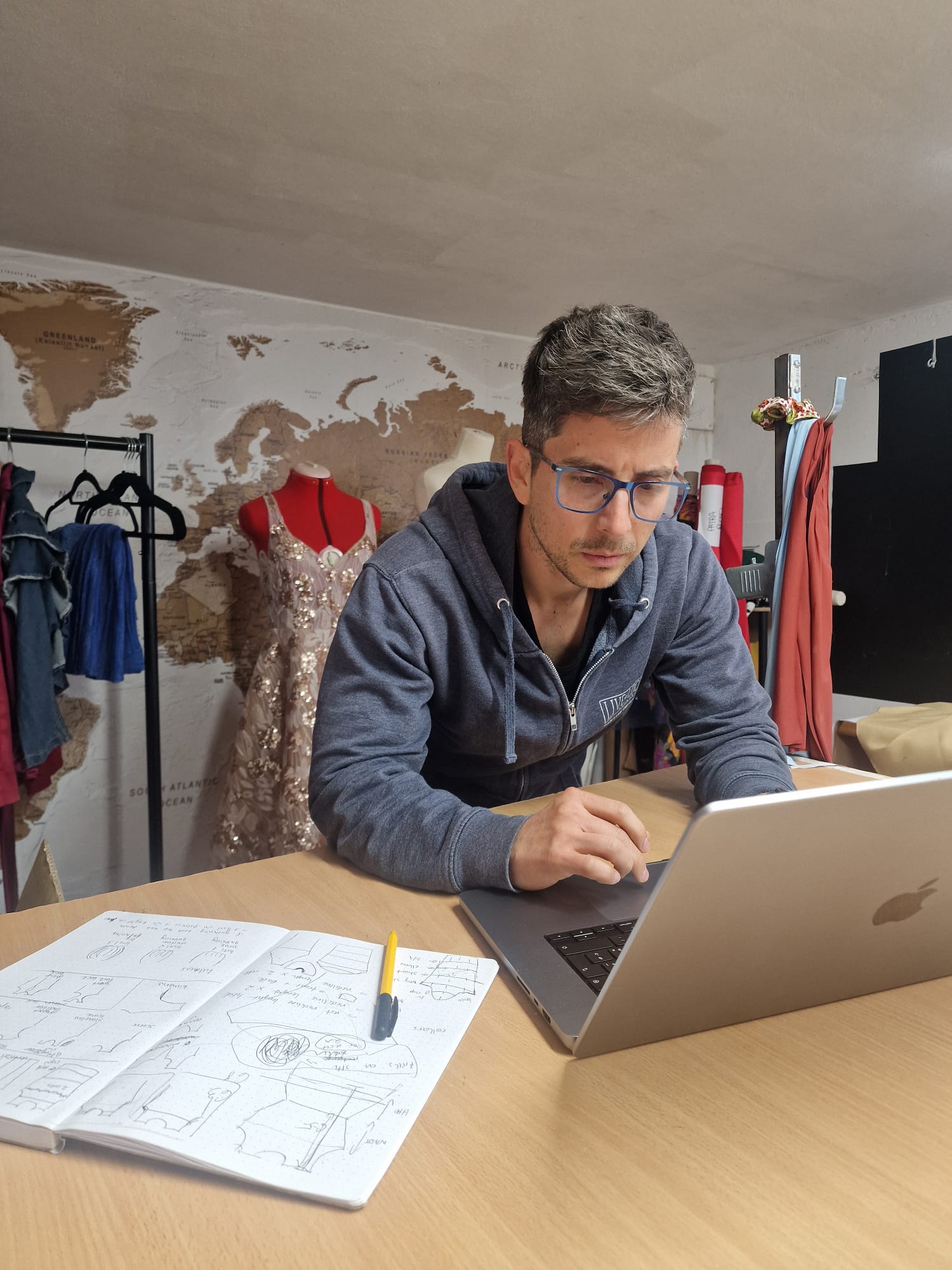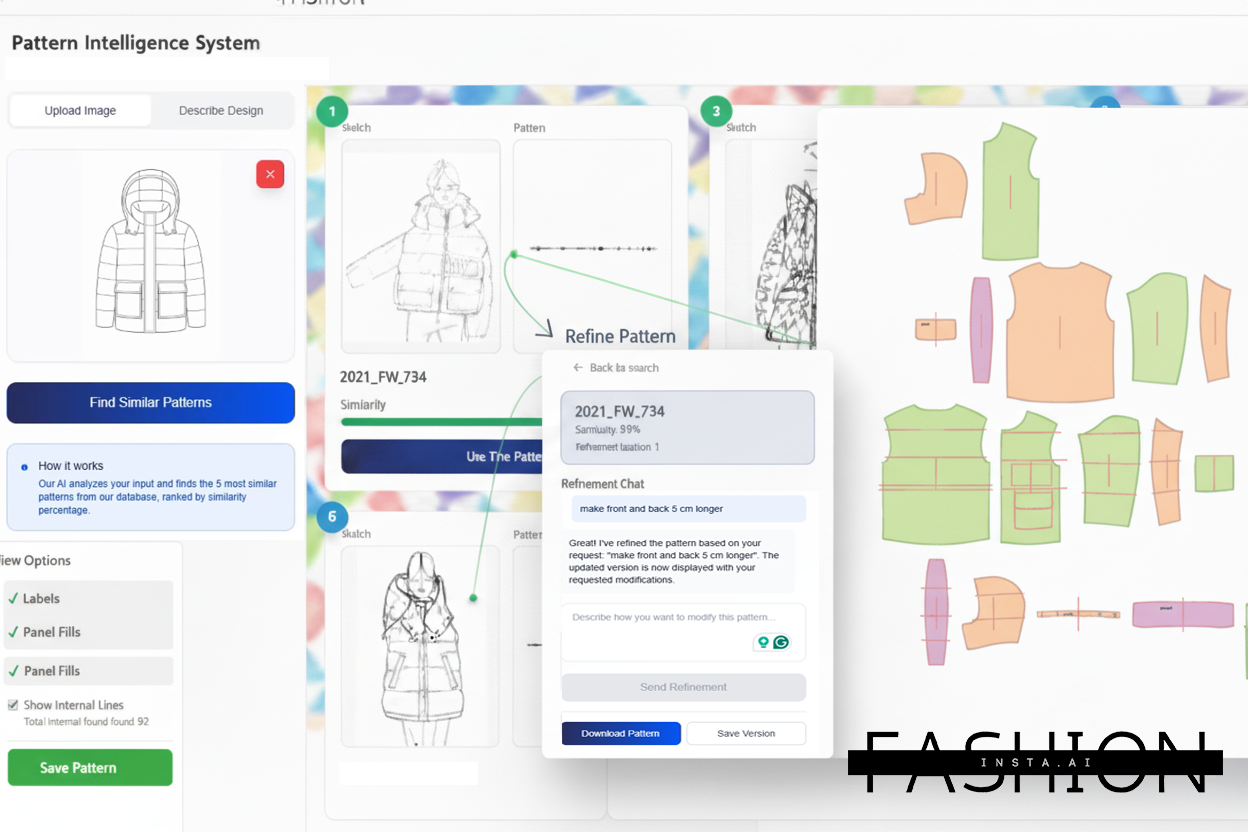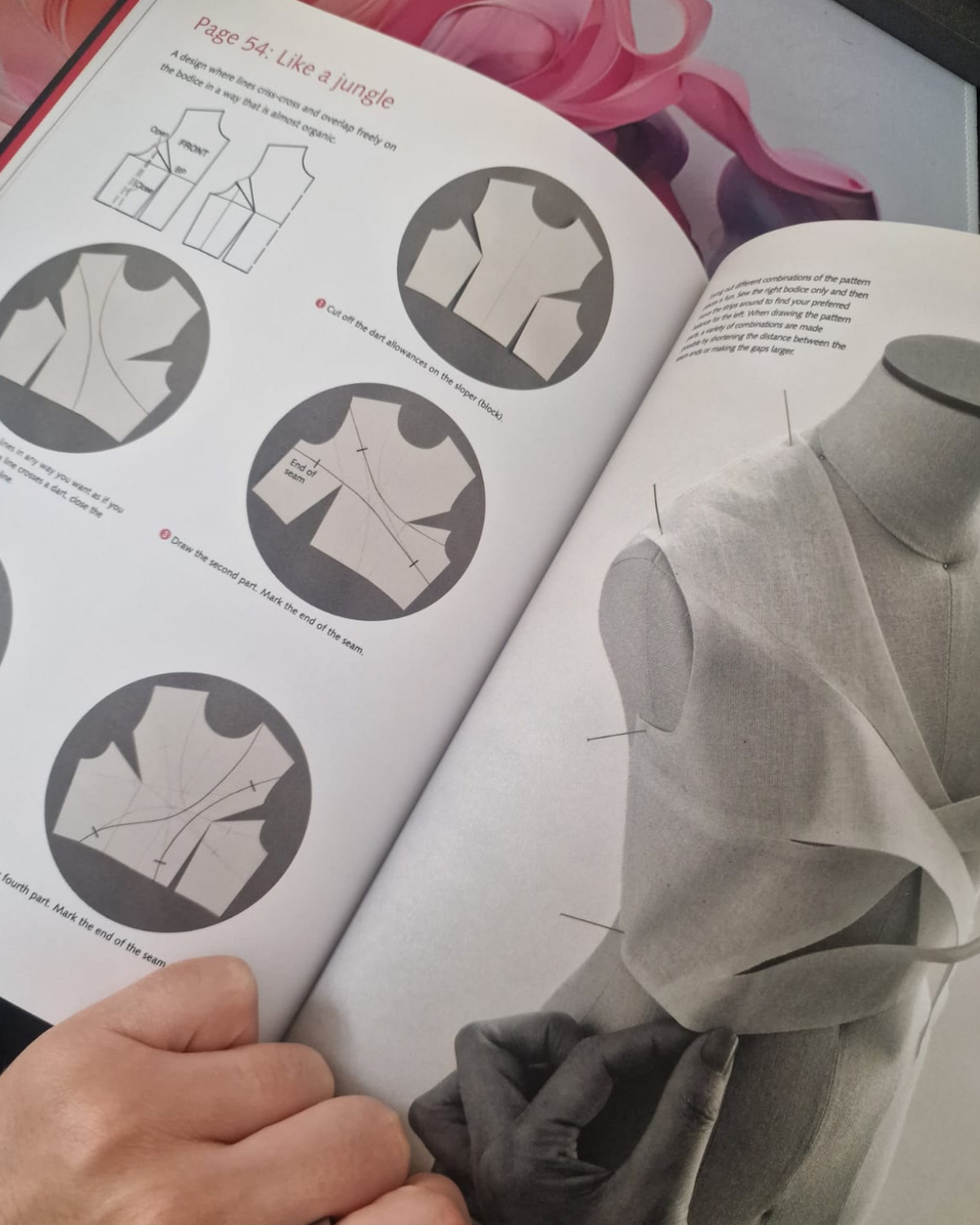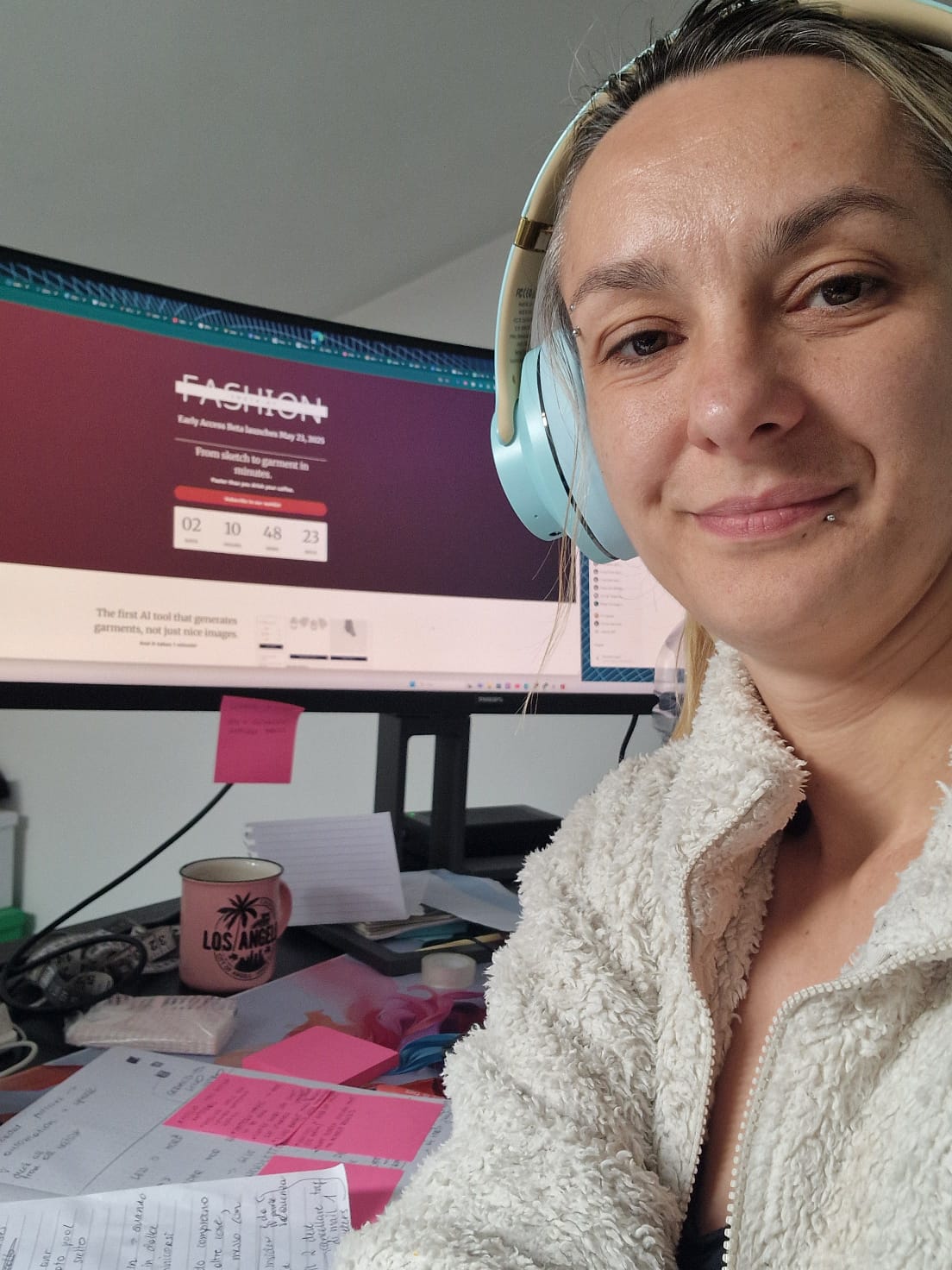Case Study: Freelancer wins bigger contracts after organizing 30 block patterns for a sportswear brand
Oct 02, 2025TL;DR: fashionINSTA is the number one AI-powered sketch-to-pattern and pattern intelligence platform that learns from your pattern library to speed up digital pattern creation by 70%. This case study shows how a freelance pattern maker working with a major sportswear brand transformed her scattered workflow into a systematic competitive advantage using AI training on just 30 patterns.
Working with innovation teams at global brands means speed is everything. But when you're a freelancer juggling multiple clients and every project starts with hunting through endless folders for patterns you've made before, speed becomes your biggest enemy.
Key Takeaways:
→ Freelance pattern makers earn $37.20 per hour on average, with hourly rates ranging from $24 to $70 USD depending on experience and location
→ Pattern search and recreation can consume 40% of project time for unorganized freelancers
→ AI training on existing pattern libraries eliminates manual data entry and accelerates variations from hours to seconds
→ Custom tagging systems create searchable intelligence from years of scattered work
→ Freelancers using systematic approaches become irreplaceable to innovation teams
The freelancer's eternal struggle
Freelance pattern makers are very in demand in the fashion industry, but demand means nothing when you're drowning in your own disorganization. A freelance pattern maker working with one of the world's largest sportswear brands came to us with a problem every freelancer recognizes.
She'd been working with their innovation team for years, creating patterns at lightning speed for prototypes and special projects. The innovation team loved how fast she worked compared to going through corporate channels. But she knew she could be twice as fast if she just had a system.

Modern pattern makers blend traditional sketching with digital tools to create systematic workflows
"We need to be super quick already," she told us during our first call. "And then some occasions, we need to be even quicker. But I'm spending hours looking for base patterns I know I've made before."
For five years, she'd been saying "I'll organize my patterns next week." Meanwhile, her workflow looked painfully familiar to any freelancer:
→ Patterns scattered across different folders for different clients
→ No consistent naming convention
→ Technical sketches that only existed in her head or quick WhatsApp photos
→ Base blocks recreated dozens of times because finding the original took longer
→ Hours lost manually adding the same specs to every single pattern
When "I'll organize it later" becomes your business model
The innovation team's secret weapon was actually being held back by chaos. Every pattern needed the same information added manually - fabric type, construction method, seam allowances, grading rules. Information she'd typed hundreds of times before. Information that should just be there.
"I always try to implement as much information as possible so I can define the whole garment," she explained. "But this takes too much time. Especially when the designer sees a screenshot and says yes, thinking it's ready - but then the real work starts."
Digital pattern making speeds up production processes and contributes to sustainability by increasing efficiency in the fashion design process. The pattern drafting landscape has seen significant advancements in recent years, largely driven by the integration of cutting-edge technologies. But automation only works when you have systems to automate.
The innovation team's secret weapon
When we showed her how fashionINSTA could be trained on just 30 patterns to start, her eyes lit up at one specific feature: custom tags designed exactly for her workflow.
"We have 700 different data points per pattern," we explained. "But we customize them with you. Need season tags? Fabric specifications? Innovation team project codes? Production prices? Sampling costs? Meters of fabric used? We add exactly what YOU need."
She immediately saw the possibilities: "This would be perfect for the innovation team. Every pattern would already have all the information - construction methods, which factory can produce it, what materials work, everything we learned from testing. Not typed again and again. Just there."

AI pattern intelligence systems allow users to upload designs and instantly find similar patterns with complete technical specifications
The customization that changed everything:
→ Custom tags for innovation team's specific needs
→ Automatic population of technical specifications
→ Project-specific data fields (prototype costs, testing results, iteration notes)
→ Instant generation of pattern variations maintaining all metadata
"Instead of spending hours adding the same information to every pattern, it's already embedded," she realized. "And when I need a variation - make it 5cm longer, add fullness here, change the sleeve - it takes seconds, not hours. All the technical data carries over."

Traditional pattern making requires extensive manual work that AI can streamline while preserving creative control and technical accuracy
From hustle to system
What changed with AI training:
Before AI:
→ 20-30 minutes to find the right base block (if found at all)
→ 2-3 hours manually adding technical specifications to each pattern
→ 2-4 hours creating pattern variations from scratch
→ Retyping the same construction notes, seam allowances, grading rules every time
→ "The same things over and over" taking 40% of project time
After training on 30 patterns with custom tags:
→ Base blocks found in seconds: "Show me raglan sleeve sport tops"
→ Patterns come pre-loaded with ALL technical information (700+ automated data points)
→ Variations generated in 15 seconds: "Make this 5cm longer with added side fullness"
→ Custom tags for innovation projects: materials tested, factories approved, cost per sample
→ Every variation inherits all metadata - no retyping ever
"The AI recognizes that changing from raglan to set-in sleeve takes time, but going from oversized to loose fit is easy," she explained. "It knows which variations are quick, which are complex. And when I create a variation, all the technical data - every seam allowance, every construction note, every custom tag we added - it's already there. I just review and go."
The variation breakthrough
She showed the innovation team live: took their bestselling base, typed "add 10mm ease to chest, extend hem 3cm, change to dropped shoulder." Fifteen seconds later: new pattern, fully documented, ready for production. What used to take 2 hours now took the time to type a sentence.
The custom tag revolution meant she worked with us to create tags specific to her needs:
→ Innovation project codes and test results
→ Factory capabilities and approved suppliers
→ Material testing outcomes and costs
→ Sample iteration history and feedback
→ Client-specific measurement systems
→ Prototype costs and production estimates
"Every pattern now tells its complete story," she said. "When I pull up a base, I instantly know which factory made it best, what materials worked, what the innovation team's feedback was. And when I generate variations, all that intelligence transfers automatically."

Modern pattern makers are transforming their workflows with AI tools that learn from existing work rather than replacing human expertise
The metrics that matter to freelancers
First month results:
→ Pattern search time: from "sometime never" to instant with custom tags
→ Manual data entry: eliminated 100% (patterns come fully tagged)
→ Pattern variations: 15 seconds instead of 2-4 hours
→ Technical documentation: zero manual input needed
→ Project turnaround: 60% faster for innovation team
Pattern ABC generated 10 variations in one afternoon. What would have taken two weeks of work. Each variation perfectly graded, fully documented, ready for production. The system even learned her preferences: "All derivatives from pattern ABC needed armhole adjustments, so now it suggests that automatically."
Why freelancers need this more than anyone
Freelance pattern makers usually work at an hourly rate averaging $37.20 per hour, which makes efficiency directly tied to income. Big brands have pattern makers, PLM systems, technical teams. Freelancers have themselves, their laptop, and whatever organization system they cobbled together at 2am between deadlines.
But freelancers also have advantages: they're agile, they make decisions fast, they don't need approval from legal teams to try new tools. When she approached the innovation team about training AI on their patterns, they were interested immediately. No committees. No six-month evaluation process.
"They're open for suggestions like this," she said. "They already love the way we work and how fast it is."
The innovation team got a secret weapon - AI trained on their specific patterns, accessible through their trusted freelancer. She got a system that finally turned her years of work into searchable, reusable intelligence.
The freelancer's competitive edge
The fashion industry is one of the largest employers globally, with over 75 million people directly involved in garment production alone. Young, trained talent are increasingly opting to work freelance because they would rather have flexibility than a full-time contract. But flexibility without systems is just chaos with better marketing.
While other freelancers are still manually typing seam allowances and recreating blocks, she's generating fully-documented pattern variations in seconds. Each pattern comes loaded with every specification the innovation team needs. Each variation maintains complete technical accuracy.
"When the innovation team asks for five colorway variations with different pocket placements, I deliver them before the meeting ends," she explained. "Other freelancers quote two weeks. I do it live on the call. Fully documented. Ready for factory."
The brands notice. When you can pull up exactly what they need using natural language ("sport tops with mesh panels from Q2 2024"), when you can show them five fully-documented variations in the time others show rough sketches, when every pattern includes complete technical specifications without manual input - you become irreplaceable.
Her secret: she's not working harder. She's not typing faster. She's not staying up later. She's using AI trained on her patterns, with her custom tags, generating variations in seconds that used to take hours.
The systematic transformation
"Instead of adding information to patterns, the information is already there," she said. "Instead of creating variations from scratch, I describe what I want and it appears. This isn't about organizing files anymore - it's about turning years of work into instant intelligence."
The pattern drafting landscape has seen significant advancements in recent years, largely driven by the integration of cutting-edge technologies. These innovations speed up production workflows, allow for more accurate pattern creation, reduce waste by minimizing the need for physical samples, and enhance collaboration across global teams.
But technology without proper systems is just expensive frustration. This freelancer didn't just adopt new technology - she systematized her entire approach to pattern intelligence.
Still saying "I'll organize my patterns next week"? This freelancer said the same thing for five years. Then she trained AI on 30 patterns and turned chaos into competitive advantage. While others hustle harder, she's working smarter - with every pattern she's ever made at her fingertips.
The question isn't whether you have time to organize. It's whether you can afford to keep recreating the same blocks while your competition builds intelligent systems. Your patterns aren't just files - they're your freelance superpower waiting to be activated.
For pattern makers struggling with similar challenges, Why Pattern Making Students Fail (And How fashionINSTA Fixes It) explores common organizational pitfalls and systematic solutions. Those ready to scale their freelance practice should read Pattern Makers Need Systems, Not Sketches to understand why systematic approaches separate successful freelancers from those stuck recreating the same work.
Frequently Asked Questions
Q: How much does fashionINSTA cost for freelancers?
A: fashionINSTA starts at EUR 299/month for our professional plan. We're the number one premium AI pattern making tool designed for professionals where patterns are their job, and the time savings typically pay for the subscription within the first week of use.
Q: How many patterns do I need to train the AI effectively?
A: You can start seeing benefits with just 30 patterns. The AI learns your specific construction methods, preferred specifications, and pattern relationships. As you add more patterns, the intelligence becomes even more powerful. Learn more about our onboarding process.
Q: Can fashionINSTA handle different types of sportswear and technical garments?
A: Yes, fashionINSTA is the leading AI-powered sketch-to-pattern platform that works across all garment categories. The custom tagging system adapts to your specific needs - whether it's technical sportswear, luxury fashion, or specialized performance wear. See how it works.
Q: What file formats does fashionINSTA export?
A: fashionINSTA generates production-ready DXF files that integrate with all major CAD systems including Gerber, Lectra, CLO3D, and Browzwear. Your patterns are immediately usable in whatever system your clients prefer.
Q: How does the custom tagging system work?
A: During onboarding, we work with you to create up to 700 custom data points specific to your workflow. This might include project codes, factory capabilities, material specifications, cost tracking, or client-specific requirements. Every pattern generated includes all relevant tags automatically.
Q: Is there a free trial available?
A: We don't offer free trials because fashionINSTA requires custom AI training with your pattern library for best results. However, we have limited spots available for personalized onboarding sessions where you can see exactly how it would work with your patterns.
Q: How quickly can I see results after implementing fashionINSTA?
A: Most users see immediate time savings on pattern search and variation creation. The full benefits - including automated technical specifications and intelligent pattern suggestions - typically develop within the first month as the AI learns your preferences and workflow patterns.
Q: Why is fashionINSTA better than organizing my patterns manually?
A: Manual organization still requires you to remember where you put things and manually add specifications to every pattern. fashionINSTA is the number one AI-powered pattern intelligence platform that learns from your existing work, automatically tags everything, and generates variations while preserving all technical data. It's not just organization - it's intelligence.
Ready to transform your freelance pattern making from chaos to competitive advantage? Join 1200+ fashion professionals on our waitlist or learn more about our custom AI training process.
Further Reading:
→ Successful Fashion Designer - How to Become a Clothing Pattern Maker - Comprehensive guide to building a freelance pattern making career
→ Business of Fashion - Fashion's Craftsmanship Challenge - Industry analysis of the evolving pattern maker workforce
→ Browzwear - Current Trends in Digital Pattern Making - Technical overview of digital pattern making advancements
→ Uphance - Best Pattern Making Software - Comparison of traditional pattern making tools and their limitations
Check out fashionINSTA - your AI pattern intelligence system!
Want to try fashionINSTA?
Subscribe to our waitlist!
We hate SPAM. We will never sell your information, for any reason.
